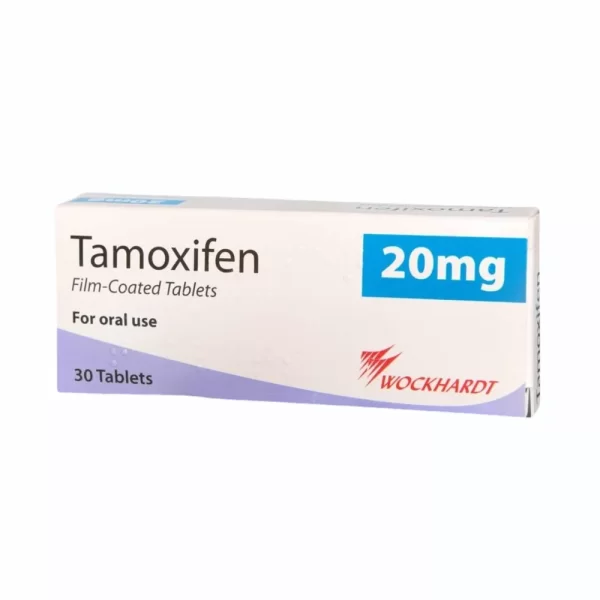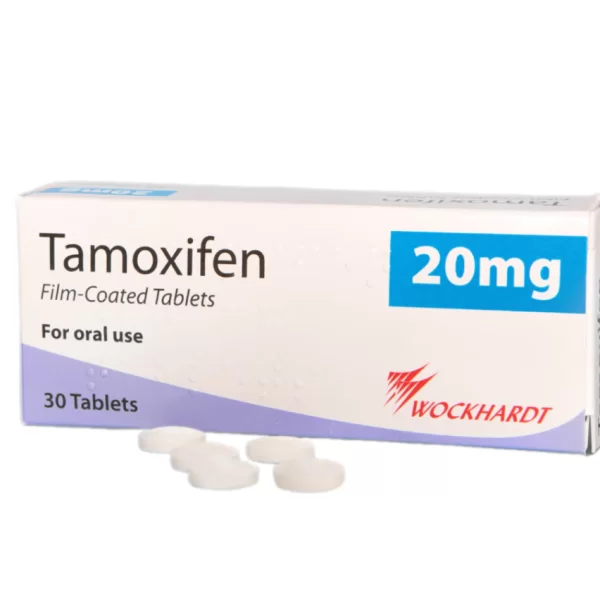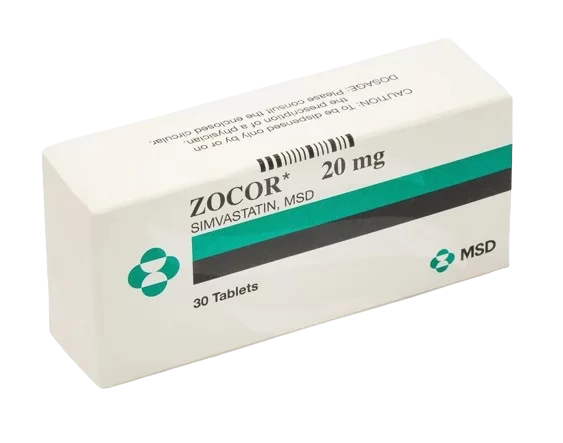
Tamoxifen
Tamoxifen - 20mg
Overview of Tamoxifen
General Introduction
Tamoxifen, also known by its brand name Nolvadex, is a medication primarily used in the treatment and prevention of breast cancer. It belongs to a class of drugs known as selective estrogen receptor modulators (SERMs). Tamoxifen works by binding to estrogen receptors on breast cancer cells, blocking the effects of estrogen, which can promote the growth of these cancer cells. It is commonly prescribed for both premenopausal and postmenopausal women and is available in tablet form, typically taken once or twice daily.
History of Development and Approval
Tamoxifen was first synthesized in the early 1960s by researchers at Imperial Chemical Industries (ICI), now known as AstraZeneca. It was initially intended as a contraceptive but was later found to have potent anti-estrogenic properties, making it suitable for breast cancer treatment. The U.S. Food and Drug Administration (FDA) approved Tamoxifen for the treatment of metastatic breast cancer in 1977, and later for adjuvant therapy in early-stage breast cancer. It has since become one of the most widely prescribed medications for breast cancer management.
Key Benefits
Tamoxifen offers several key benefits for patients with breast cancer:
- Cancer Treatment: Effectively treats hormone receptor-positive breast cancer.
- Cancer Prevention: Reduces the risk of breast cancer recurrence and is also used for breast cancer prevention in high-risk women.
- Versatile Use: Suitable for both premenopausal and postmenopausal women.
- Long-Term Benefit: Provides long-term protection against breast cancer recurrence when taken as prescribed.
Unique Properties
Tamoxifen is unique due to its dual role as both an estrogen antagonist in breast tissue and an estrogen agonist in other tissues such as the bones and uterus. This selective action allows it to effectively block estrogen's effects on breast cancer cells while maintaining beneficial estrogenic effects in other parts of the body, such as preserving bone density in postmenopausal women.
Comparison with Similar Medications
Compared to other hormone therapies for breast cancer, Tamoxifen offers distinct advantages:
- Proven Efficacy: Extensive clinical trials have demonstrated its effectiveness in reducing breast cancer recurrence and mortality.
- Long Track Record: It has been in use for several decades, providing a wealth of clinical experience and safety data.
- Combination Therapy: Can be used in combination with other treatments such as chemotherapy, radiation, and other hormonal therapies for enhanced efficacy.
Safety and Tolerability
Tamoxifen is generally well-tolerated when used as directed. Common side effects include hot flashes, vaginal discharge, and menstrual irregularities. Serious side effects are rare but may include blood clots, stroke, and uterine cancer. Regular monitoring by a healthcare provider is recommended to ensure patient safety and optimal therapeutic outcomes.
Indications for Use
Diseases and Conditions Treated
Tamoxifen is prescribed for:
- Hormone Receptor-Positive Breast Cancer: Treatment of both early-stage and metastatic breast cancer.
- Breast Cancer Prevention: Reduces the risk of breast cancer in high-risk women, such as those with a family history of the disease or genetic predisposition (e.g., BRCA1 or BRCA2 mutations).
- Ductal Carcinoma In Situ (DCIS): Used to reduce the risk of invasive breast cancer following surgery and radiation therapy for DCIS.
Symptoms Indicating Use
Patients diagnosed with hormone receptor-positive breast cancer or those at high risk for developing breast cancer may benefit from Tamoxifen. It is particularly effective in reducing the risk of cancer recurrence and in preventing the development of new breast cancer in high-risk individuals.
Dosage and Administration
Recommended Dosage for Adults
The typical dose of Tamoxifen for adults is 20 mg once daily. For some patients, the dose may be divided into two 10 mg doses taken in the morning and evening. The duration of treatment is usually five years, but it may be extended based on the patient's risk profile and response to therapy.
Dosage for Children
Tamoxifen is not commonly prescribed for children. In rare cases where it is indicated for pediatric use, such as in the treatment of certain types of gynecomastia, dosing must be carefully determined by a healthcare provider based on the child's specific condition and response to treatment.
Dosage for Elderly Patients
No specific dosage adjustments are required for elderly patients. However, elderly patients should be monitored closely due to the increased risk of side effects such as thromboembolic events and stroke.
Optimal Timing of Administration
Tamoxifen can be taken with or without food. It is important to take the medication at the same time each day to maintain consistent blood levels. If a dose is missed, it should be taken as soon as remembered unless it is almost time for the next dose, in which case the missed dose should be skipped.
Frequency of Administration
Tamoxifen is typically administered once daily. Adhering to the prescribed frequency ensures the medication's effectiveness and minimizes the risk of missed doses.
Impact of Food on Efficacy
Food does not significantly impact the efficacy of Tamoxifen. Patients can take it with or without food according to their preference, making it a flexible option for managing hormone receptor-positive breast cancer.
Pharmacological Action
Mechanism of Action
Tamoxifen works by binding to estrogen receptors on breast cancer cells, blocking the effects of estrogen. This action inhibits the growth and proliferation of estrogen-dependent breast cancer cells. Tamoxifen acts as an estrogen antagonist in breast tissue, preventing the hormone from stimulating cancer cell growth.
Molecular and Cellular Targets
Tamoxifen targets estrogen receptors on the surface of breast cancer cells. By blocking these receptors, it prevents estrogen from binding and activating the cancer cells, thereby inhibiting their growth and proliferation. This selective action helps to reduce the risk of cancer recurrence and progression.
Metabolic Pathways
Tamoxifen is metabolized in the liver to its active metabolites, including 4-hydroxytamoxifen and endoxifen. These metabolites have higher affinity for estrogen receptors and contribute to the overall therapeutic effect of the drug. Tamoxifen and its metabolites are primarily excreted in the feces.
Biochemical Changes
By blocking estrogen receptors, Tamoxifen reduces the growth and proliferation of hormone receptor-positive breast cancer cells. This biochemical change leads to decreased tumor size and lower risk of cancer recurrence. The drug's effect on estrogen receptors also results in changes in hormone levels, which can cause side effects such as hot flashes and menstrual irregularities.
Physiological Effects
The physiological effects of Tamoxifen include reduced tumor size, lower risk of breast cancer recurrence, and prevention of new breast cancer development in high-risk individuals. Patients may experience improvements in overall survival and quality of life due to the effective management of breast cancer symptoms and progression.
Composition
Active Ingredient
The active ingredient in Tamoxifen is tamoxifen citrate. It is available in tablet form, typically in strengths of 10 mg and 20 mg.
Inactive Ingredients
Inactive ingredients in Tamoxifen tablets may include lactose, magnesium stearate, microcrystalline cellulose, and pregelatinized starch. These ingredients help in the formulation and stability of the medication, ensuring that it is effective and safe for patient use.
Role of Each Component
Tamoxifen citrate acts as the primary therapeutic agent, while inactive ingredients ensure proper formulation, stability, and absorption of the medication. The inactive ingredients also contribute to the tablet's integrity and ease of administration.
Side Effects
Common Side Effects
Common side effects of Tamoxifen include:
- Hot Flashes: Sudden feelings of warmth, often accompanied by sweating.
- Vaginal Discharge: Increased vaginal secretions.
- Menstrual Irregularities: Changes in menstrual cycle, including missed periods.
- Nausea: Mild to moderate nausea, sometimes accompanied by vomiting.
Rare Side Effects
Rare side effects may include:
- Thromboembolic Events: Blood clots in veins or lungs.
- Stroke: Increased risk of stroke, particularly in older women.
- Endometrial Cancer: Slightly increased risk of uterine cancer in postmenopausal women.
- Vision Changes: Cataracts or other changes in vision.
Serious Side Effects
Serious side effects requiring immediate medical attention include:
- Severe Allergic Reactions: Symptoms such as rash, itching, swelling, and difficulty breathing.
- Severe Blood Clots: Symptoms such as pain, redness, or swelling in the legs, chest pain, or shortness of breath.
- Signs of Stroke: Sudden numbness or weakness, especially on one side of the body, sudden confusion, trouble speaking, or severe headache.
Frequency and Severity
Most side effects are mild and transient, occurring primarily during the initial phase of treatment. Serious side effects are rare but warrant close monitoring by a healthcare provider. Regular follow-up appointments can help manage and mitigate these risks.
Prevention of Side Effects
General Precautions
To minimize side effects, patients should follow the prescribed dosage and avoid taking more than the recommended dose. It is important to inform the healthcare provider of any existing medical conditions and medications being taken, particularly those that may interact with Tamoxifen.
Recommendations for Better Tolerability
Using Tamoxifen as directed and maintaining regular follow-up appointments with a healthcare provider can improve tolerability. Patients should be educated on the importance of adhering to the prescribed treatment regimen and monitoring their response to the medication. Staying hydrated and maintaining a balanced diet can also help reduce gastrointestinal side effects.
Contraindications
Conditions and Diseases
Tamoxifen is contraindicated in patients with:
- Known Hypersensitivity: To tamoxifen or any of its components.
- History of Blood Clots: Such as deep vein thrombosis (DVT) or pulmonary embolism (PE).
- Pregnancy: Due to potential harm to the fetus.
Explanation of Contraindications
Tamoxifen may exacerbate certain conditions, such as a history of blood clots, due to its potential to increase the risk of thromboembolic events. Hypersensitivity reactions can cause severe allergic responses, making it crucial to assess a patient's medical history before prescribing Tamoxifen.
Warnings and Precautions
Potential Risks
Patients should be monitored for signs of blood clots, stroke, and endometrial cancer, particularly during the initial phase of treatment and during dose adjustments. Regular blood tests may be required to monitor liver function, especially in patients with pre-existing liver conditions.
Safety Measures
Regular monitoring by a healthcare provider, starting with a low dose, and adjusting as needed can help mitigate risks. Patients should be instructed to report any symptoms of severe leg pain, chest pain, shortness of breath, or unusual vaginal bleeding immediately.
Missed Dose
Immediate Actions
If a dose is missed, take it as soon as remembered unless it is almost time for the next dose. Do not double the dose to catch up. Continue with the regular dosing schedule to maintain consistent blood levels of the medication.
Preventive Strategies
Using reminders and keeping a consistent schedule can help prevent missed doses. Patients can set alarms, use medication reminder apps, or keep a medication diary to track their doses, ensuring adherence to the treatment regimen.
Drug Interactions
Interacting Medications
Tamoxifen may interact with various medications, including:
- Anticoagulants: Such as warfarin, which can increase the risk of bleeding.
- SSRIs: Such as fluoxetine and paroxetine, which can reduce the effectiveness of Tamoxifen by inhibiting its metabolism.
- CYP3A4 Inhibitors: Such as ketoconazole, which can increase the levels of Tamoxifen and its active metabolites.
Effects of Interactions
These interactions can affect the metabolism and efficacy of Tamoxifen or the concomitant medications. For instance, combining Tamoxifen with SSRIs may reduce its effectiveness in treating breast cancer. Monitoring for side effects and adjusting dosages may be necessary to manage these interactions.
Avoiding Interactions
Inform the healthcare provider of all medications being taken to avoid potential interactions. Patients should not start, stop, or change the dosage of any medicines without their healthcare provider’s approval. Regular reviews of medication regimens can help identify and manage potential interactions.
Overdose
Symptoms of Overdose
Symptoms of overdose may include severe dizziness, fainting, and irregular heartbeat. Seek emergency medical help if an overdose is suspected.
Immediate Actions
Seek emergency medical help if an overdose is suspected. Supportive measures and symptomatic treatment are recommended. Activated charcoal may be administered if the overdose is recent, and intravenous fluids may be given to maintain hydration and support cardiovascular function.
Pharmacokinetics
Absorption
Tamoxifen is well-absorbed from the gastrointestinal tract, with peak plasma concentrations reached within 4 to 7 hours after oral administration. The bioavailability of Tamoxifen is approximately 20-30%.
Distribution
Tamoxifen is widely distributed throughout the body and is extensively bound to plasma proteins, primarily albumin. It crosses the blood-brain barrier and is also distributed to tissues such as the liver and uterus.
Metabolism
Tamoxifen is metabolized in the liver by cytochrome P450 enzymes, primarily CYP3A4 and CYP2D6, to its active metabolites, including 4-hydroxytamoxifen and endoxifen. These metabolites have higher affinity for estrogen receptors and contribute to the overall therapeutic effect of the drug.
Elimination
The half-life of Tamoxifen is approximately 5 to 7 days, allowing for once-daily dosing. It is excreted primarily in the feces, with a small amount eliminated via the urine.
Dosage Forms
Available Forms and Dosages
Tamoxifen is available in tablet form, typically in strengths of 10 mg and 20 mg. This single dosage strength simplifies dosing regimens and ensures consistent blood levels of the medication.
Benefits of Different Forms
The availability of a single strength tablet simplifies the dosing regimen and ensures consistent patient adherence. The 10 mg and 20 mg tablets are designed to provide optimal therapeutic effects with a convenient once-daily dosing schedule.
Pregnancy and Breastfeeding
Safety During Pregnancy
Tamoxifen should be used during pregnancy only if the potential benefit justifies the potential risk to the fetus. There is limited data on the use of Tamoxifen in pregnant women, and animal studies have shown adverse effects on the fetus. Pregnant women should discuss the potential risks and benefits with their healthcare provider before starting treatment.
Safety During Breastfeeding
It is not known whether Tamoxifen is excreted in human milk. Due to the potential for adverse reactions in nursing infants, a decision should be made whether to discontinue breastfeeding or discontinue the drug, considering the importance of the drug to the mother. Breastfeeding mothers should consult their healthcare provider to weigh the potential risks and benefits.
Storage Conditions
General Recommendations
Store Tamoxifen at room temperature between 20°C to 25°C (68°F to 77°F). Keep the medication in its original container, tightly closed, and out of reach of children and pets.
Specific Storage Instructions
Tamoxifen tablets should be stored in a cool, dry place away from direct sunlight and moisture. Store according to the manufacturer's instructions to protect the medication from light and moisture.
Expiry and Stability
Check the expiration date on the package and do not use Tamoxifen past the expiration date. Proper storage ensures the medication remains effective and safe to use. Dispose of expired or unused medication according to local regulations to prevent accidental exposure or misuse.
Clinical Trials and Efficacy
Overview of Clinical Studies
Tamoxifen has undergone extensive clinical trials to evaluate its safety and efficacy in treating and preventing breast cancer. These studies included randomized, double-blind, placebo-controlled trials involving thousands of patients worldwide.
Results and Findings
Clinical trials have shown that Tamoxifen significantly reduces the risk of breast cancer recurrence and mortality in patients with hormone receptor-positive breast cancer. Patients treated with Tamoxifen demonstrated better outcomes compared to those receiving a placebo or no treatment.
Comparative Studies
Studies comparing Tamoxifen with other hormone therapies, such as aromatase inhibitors, have shown that Tamoxifen provides effective breast cancer treatment with a favorable safety profile. Its unique mechanism of action and long track record make it a valuable option for many healthcare providers.
Conclusion
Summary of Key Points
Tamoxifen is an effective hormone therapy for the treatment and prevention of hormone receptor-positive breast cancer. Its ability to block estrogen receptors provides significant therapeutic benefits for patients with these conditions. The medication is generally well-tolerated, with a well-documented safety profile.
Recommendations
For optimal results, patients should follow their healthcare provider's instructions regarding dosage and administration. Regular monitoring and follow-up appointments are essential to ensure the medication's effectiveness and manage any side effects. Patients should maintain a healthy lifestyle, including proper diet and exercise, to support overall health while on Tamoxifen therapy.
Final Thoughts
Tamoxifen significantly improves the quality of life for patients suffering from hormone receptor-positive breast cancer by effectively managing symptoms and reducing the risk of recurrence. With its proven efficacy and safety, Tamoxifen remains a trusted choice for healthcare providers and patients in the management of these conditions.





